A Journey to the Gaza Envelope
Tour guide: Pepe Heiblum, member of Kibbutz Mefalsim
During a recent trip to Israel, I visited the Gaza Envelope, Israel's border communities along the border with Gaza, with the goal of documenting the experience. Since the October 7, 2023, Palestinian Hamas-led attack on Israel, global media coverage has largely focused on the destruction in Gaza, overlooking the brutality of that initial assault and the profound trauma inflicted on Israeli civilians.
This visit aimed to offer a different, neglected side of the story. The Israeli communities along the Gaza border carry deep scars from that day, with stories of loss, heroism, and survival that deserve to be heard.
It’s important to understand that much of the devastation in Gaza stems from Hamas’s own strategic choices. By embedding its fighters and weapons within civilian areas, locating tunnels and command centers under schools and hospitals, and booby-trapping nearly every building in the strip, Hamas intentionally endangers its own population, hoping to provoke international condemnation of Israel. This tactic, which sacrifices lives for propaganda, lies at the heart of the tragedy.
Through this journey, we sought to bear witness, not only to the physical destruction but to the human resilience that continues to define the people living along Israel’s southern border.
First Stop: Kibbutz Nahal Oz
Our tour begins at Kibbutz Nahal Oz, the closest Israeli community to the Gaza border. Established over 70 years ago, Nahal Oz is known for its innovation in water-sensitive agriculture and its strong communal spirit.
On October 7, 2023, the kibbutz was preparing for a festive event, expecting many visitors as families gathered for a celebration. Tragically, that morning became one of the darkest in the kibbutz’s history, as Palestinian Hamas-led terrorists infiltrated the community during the surprise attack on Israel.
The attackers had precise knowledge of the kibbutz layout and its residents, reportedly targeting key figures responsible for security first. Despite this, the bravery of the kibbutz's 11 local fighters helped prevent even greater loss. Among the stories of courage is that of the Military Security Coordinator (רבש"ץ), who managed to save a young boy after his entire family had been murdered.
The attack on Nahal Oz came in two waves, one at 6:29 a.m. and another at 8:00 a.m. 16 members of the kibbutz were murdered, and 8 civilians were taken hostage to Gaza. Of the approximately 450 residents who once lived there, only 60 have since returned.
It’s also worth noting the painful history that stretches further back. Roy Rotenberg, the first person murdered by terrorists from Gaza, was killed here in 1956, a reminder of the longstanding tensions in this area.
As we stood in the kibbutz, just meters from an active war zone, the sound of distant artillery echoed around us. Our guide told us this is considered a relatively quiet day.
Visiting Nahal Oz today is both a tribute to the resilience of its people and a sobering experience that underscores the human cost of conflict.
Second Stop: Tkuma, the Wall of the Burnt Cars
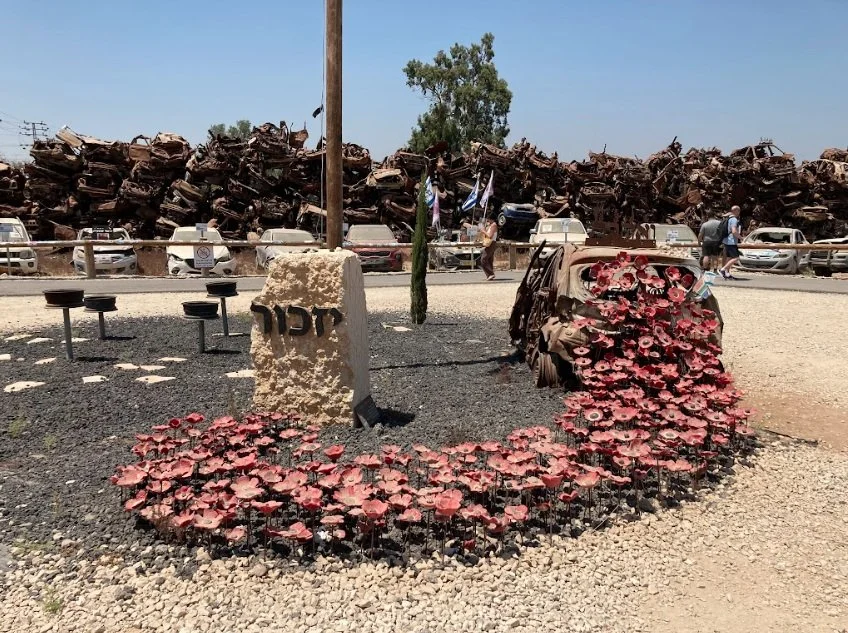
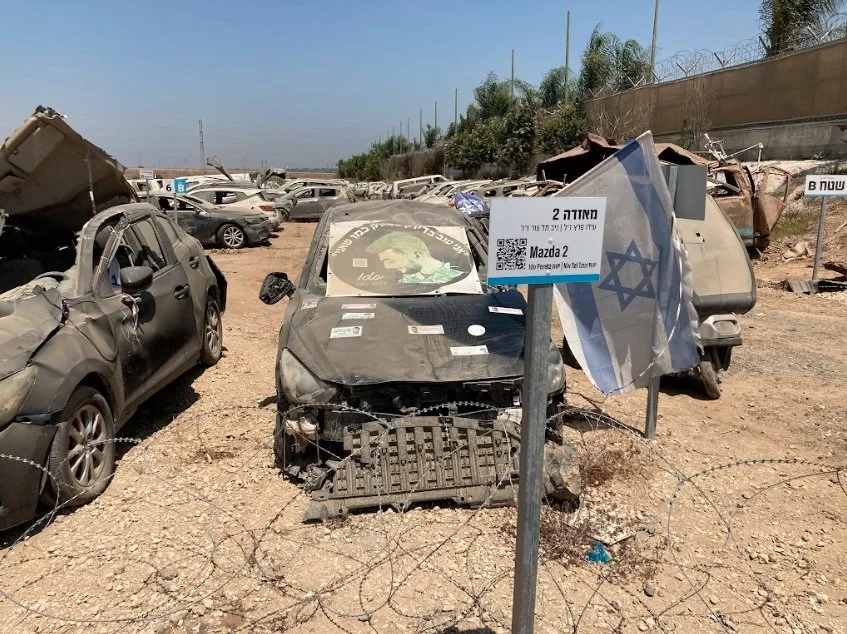
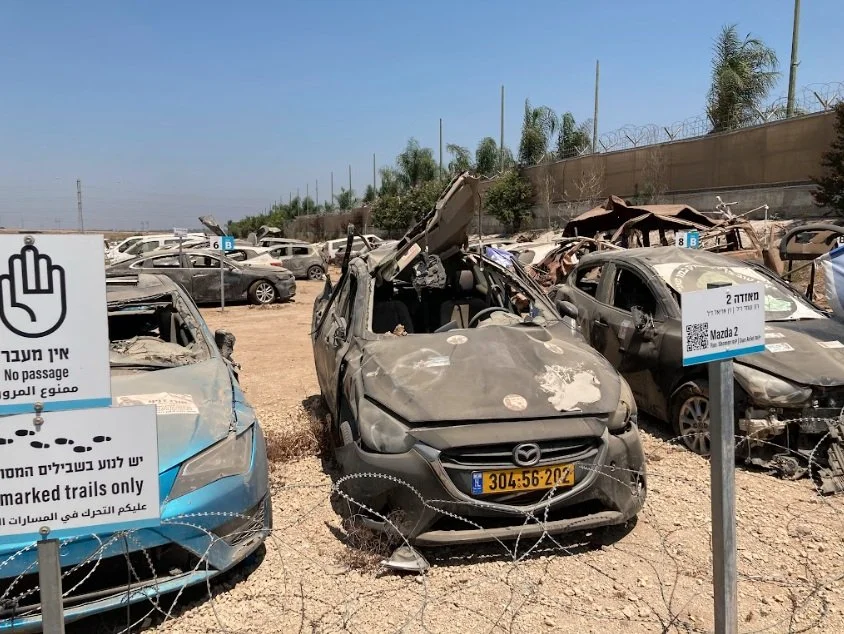

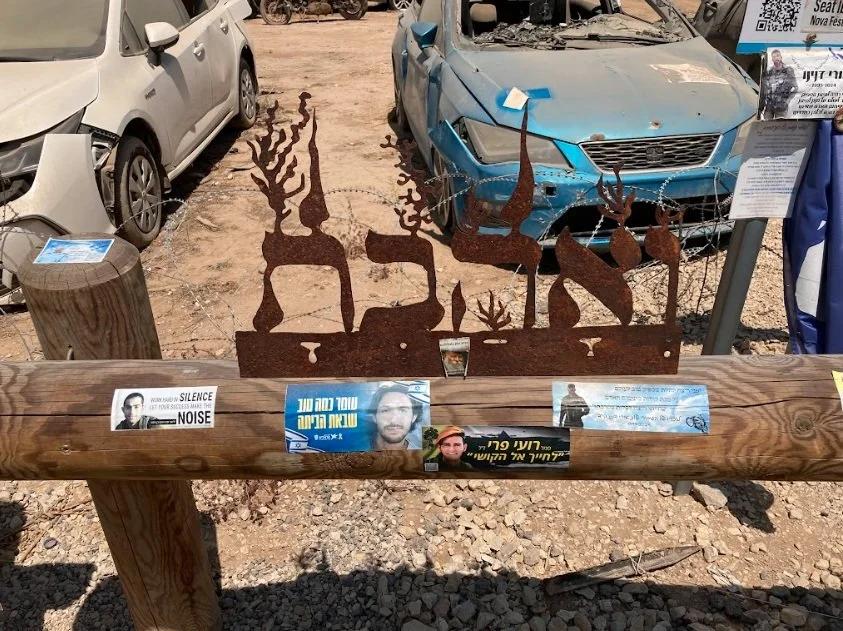
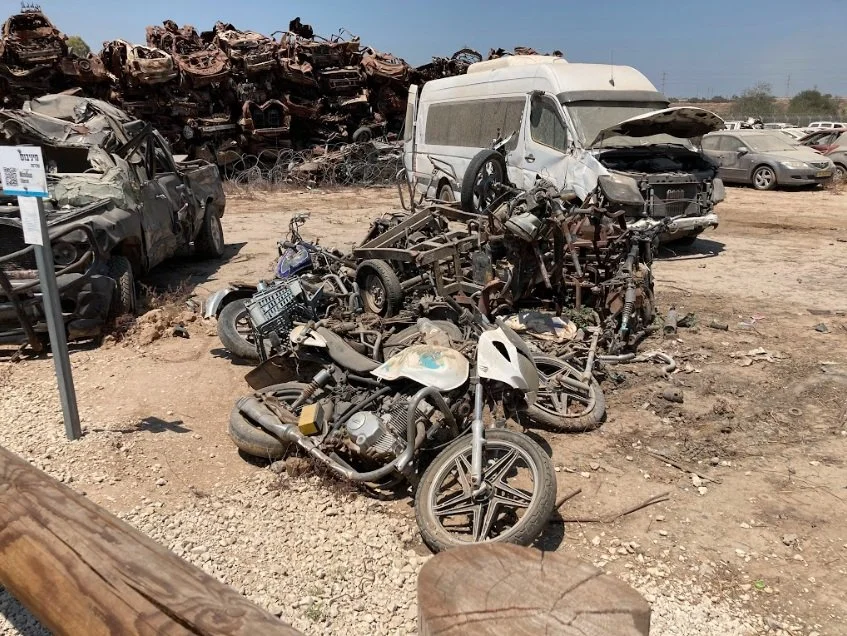
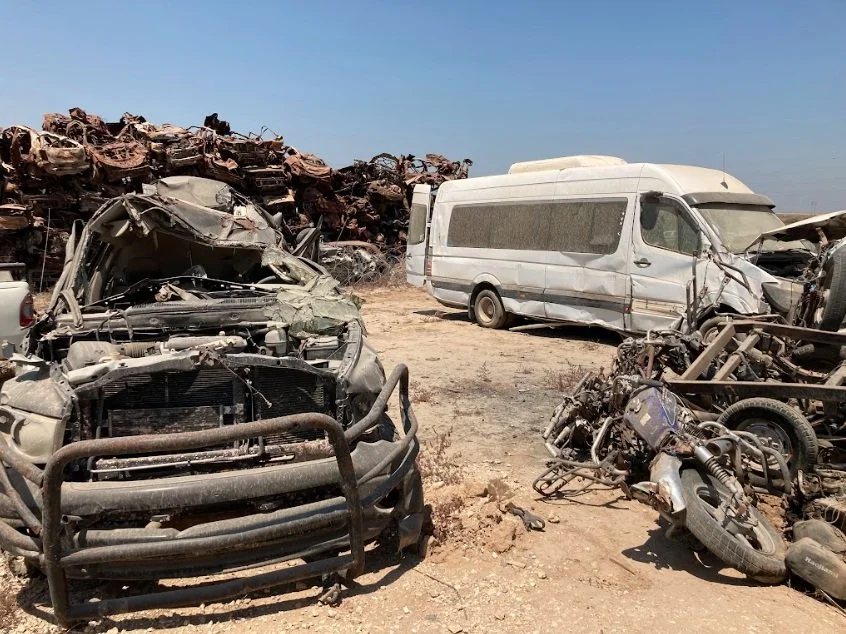


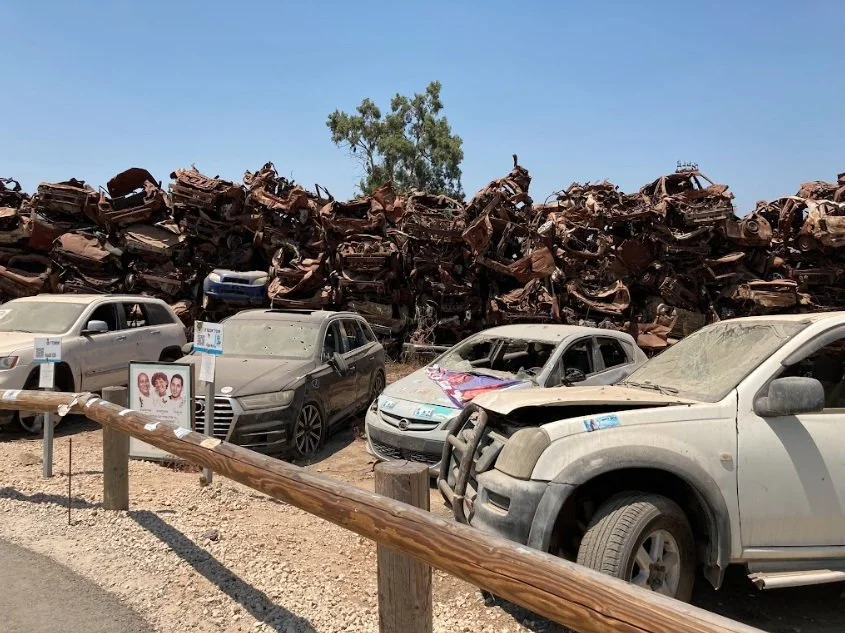

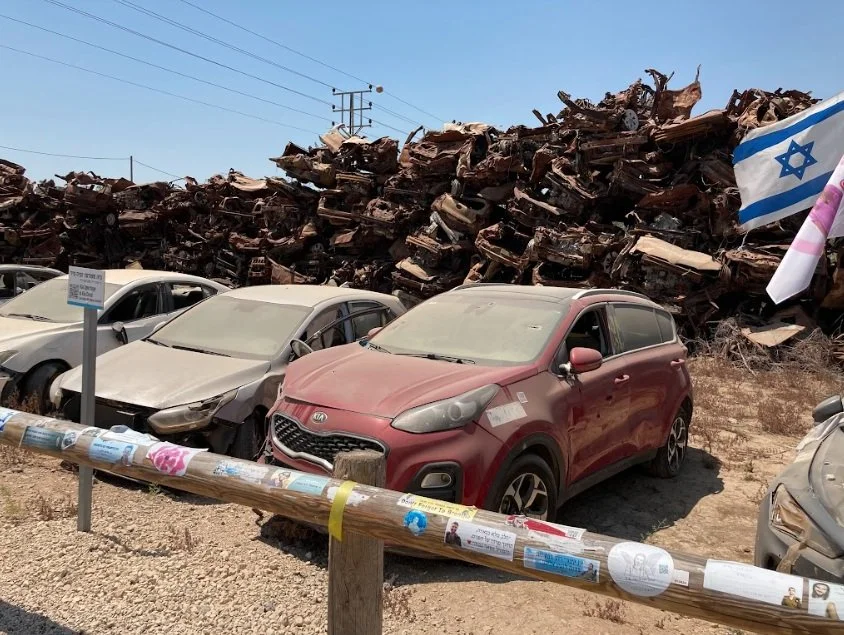
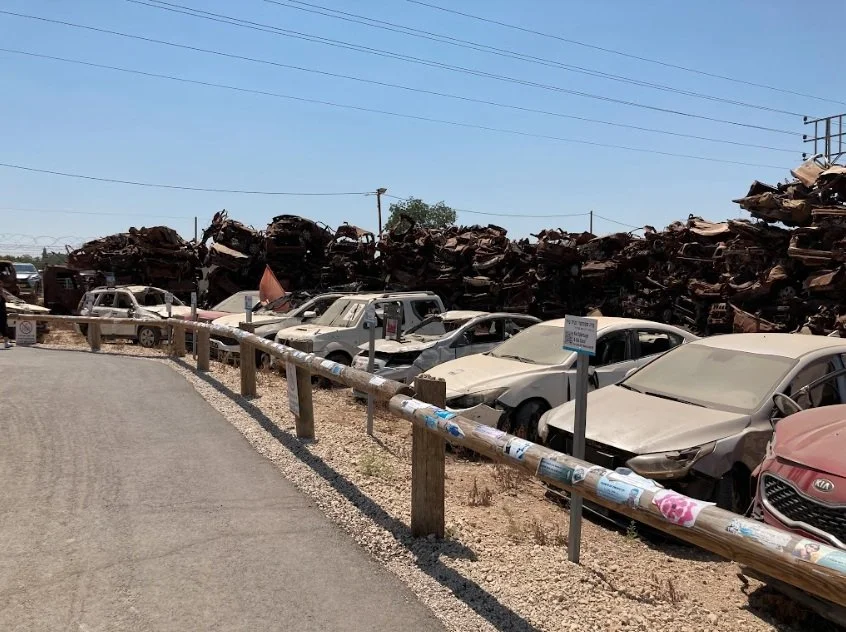
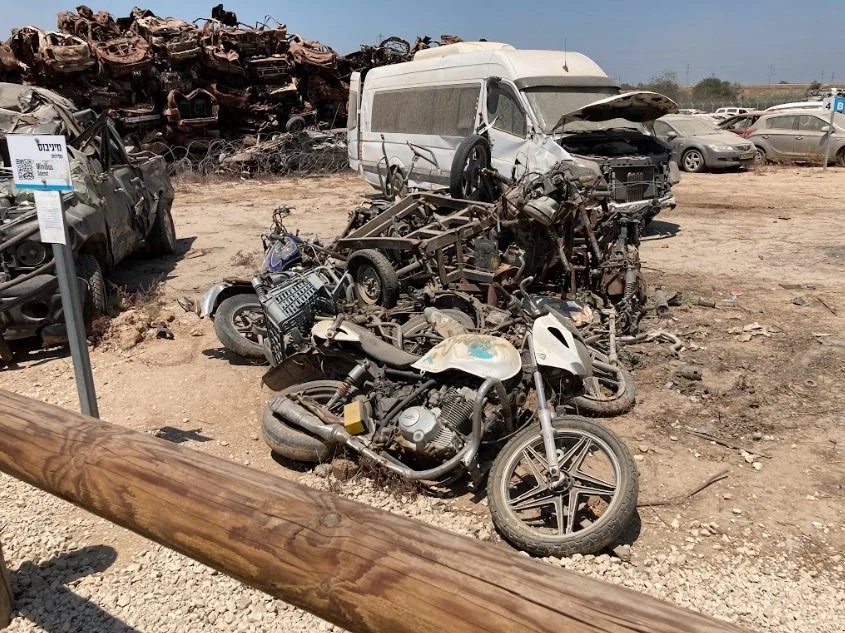
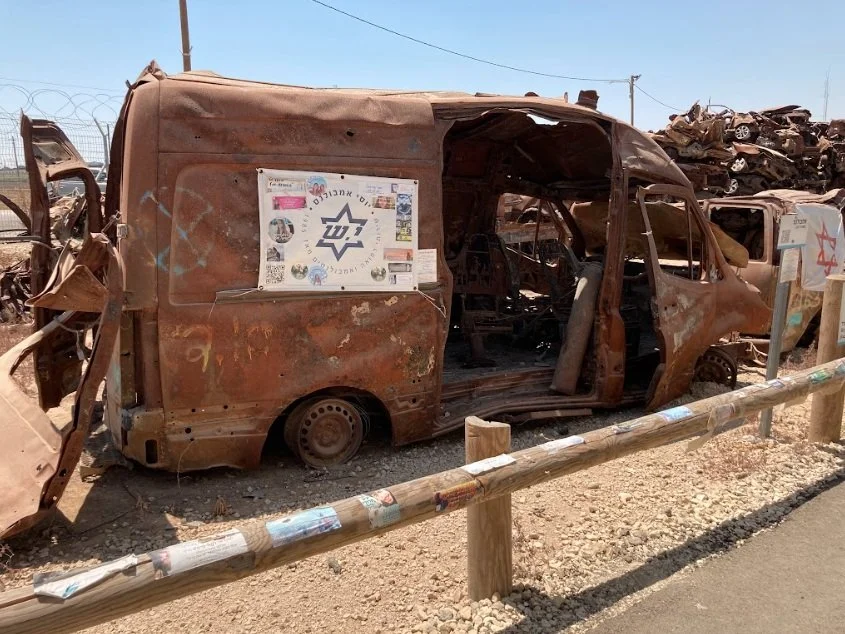
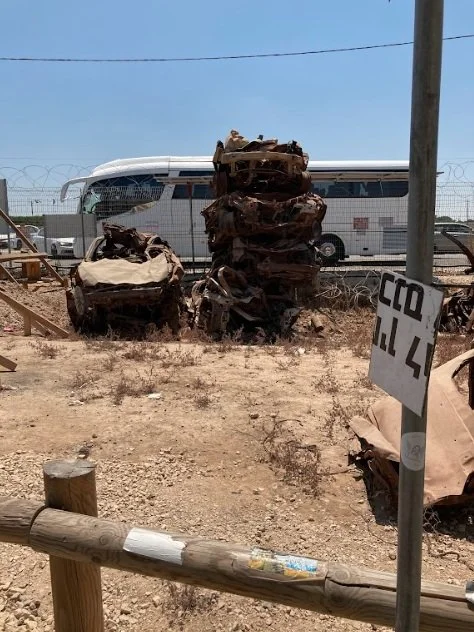

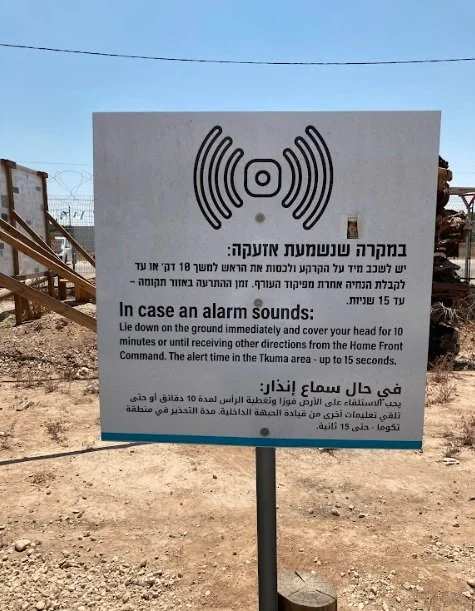
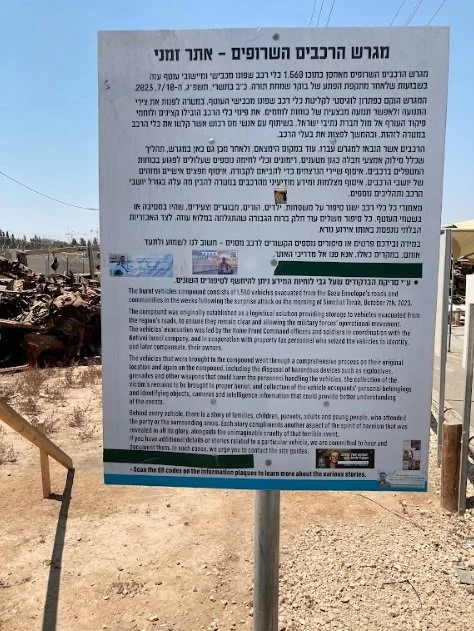
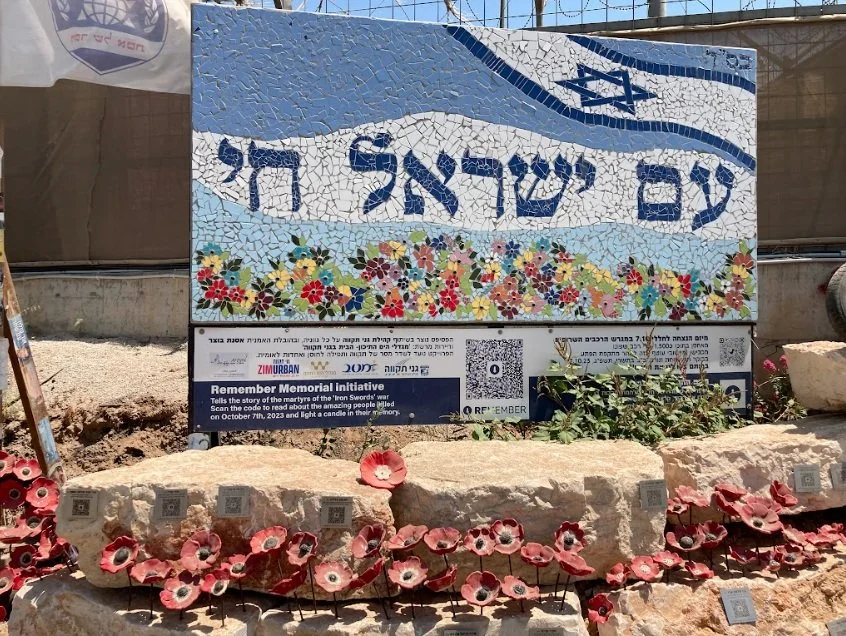
As we made our way toward Tkuma, we pass the Nahal Oz military base, where 54 soldiers were murdered, and 7 female lookout soldiers were taken hostage into Gaza. We continued west of Moshav Tkuma to a haunting site known as “The Wall of the Burnt Cars.”
This place has become an official monument, a sobering memorial made of scorched vehicles. Dozens of burnt-out cars are piled here, each one a silent witness to the horrors of October 7, 2023. It's hard not to draw a parallel to other dark chapters in Jewish history, such as the Holocaust, where piles of objects such as shoes, suitcases, and personal items in concentration camps stand as enduring reminders of human loss and suffering.
We learned that many of the vehicles here were targeted with deliberate cruelty. Terrorists often aimed at gas tanks to inflict maximum destruction.
One of the most harrowing sights at the memorial is a destroyed ambulance, the same one that was stationed at the Nova Music Festival. During the Hamas attack, 18 people sought refuge inside that ambulance. A terrorist fired an RPG directly at it, killing everyone inside. The explosion was so devastating that it became extremely difficult to identify the victims. Tragically, three others who had taken cover behind the ambulance were also killed.
Also displayed at the site are the vehicles used by the terrorists during the infiltration, mostly pickup trucks and motorcycles, stark reminders of the methodical and violent nature of the assault.
Beside many of the cars are QR codes, which visitors can scan to learn more about the individual stories behind each vehicle, stories of the people who once filled them with life.
Third Stop: The Garden Center “Derech Ha-zayit” (The Olive Road), Moshav Zimrat











Our next stop was Derech Ha-zayit, The Olive Road, a beautiful garden center in Moshav Zimrat. We paused here for a short break and, just as importantly, to support a local business deeply affected by the war.
Surrounded by vibrant plants and carefully tended landscapes, one of the gardeners introduced us to one of the oldest olive trees in Israel, estimated to be over 3,000 years old. Locals call it the Wishing Tree.
But perhaps the most powerful story came from a different olive tree, one that now stands as a symbol of resilience. In 2019, during a previous Hamas attack, this particular tree was struck directly by a missile, right through the center of its trunk. And yet, against all odds, it survived. Today, new branches are sprouting, and it continues to grow, an enduring reminder of nature’s will to live and the spirit of survival that defines this region.
Fourth Stop: The Nova Festival location near Kibbutz Re’im
Visiting the Nova Festival site, where the brutal massacre took place, was an incredibly powerful and painful experience. The grounds are now filled with memorials and photos of the young people who were murdered by Hamas terrorists, as well as those who were taken hostage. We walked through the area, reading the individual stories, each one a life full of promise, now a heartbreaking memory. In total, 378 civilians and security personnel were killed, hundreds more were injured, and 44 were abducted and taken into Gaza.









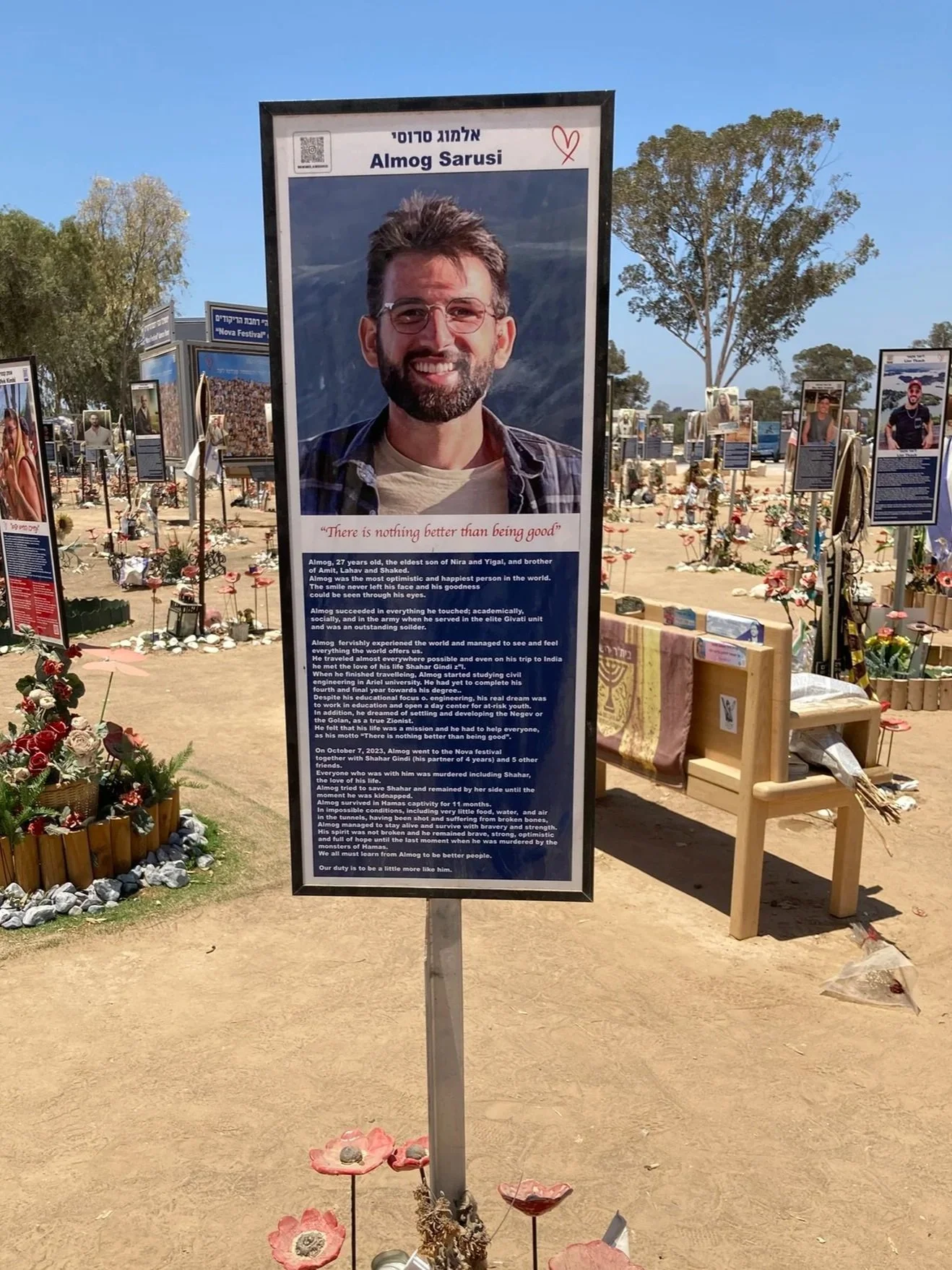
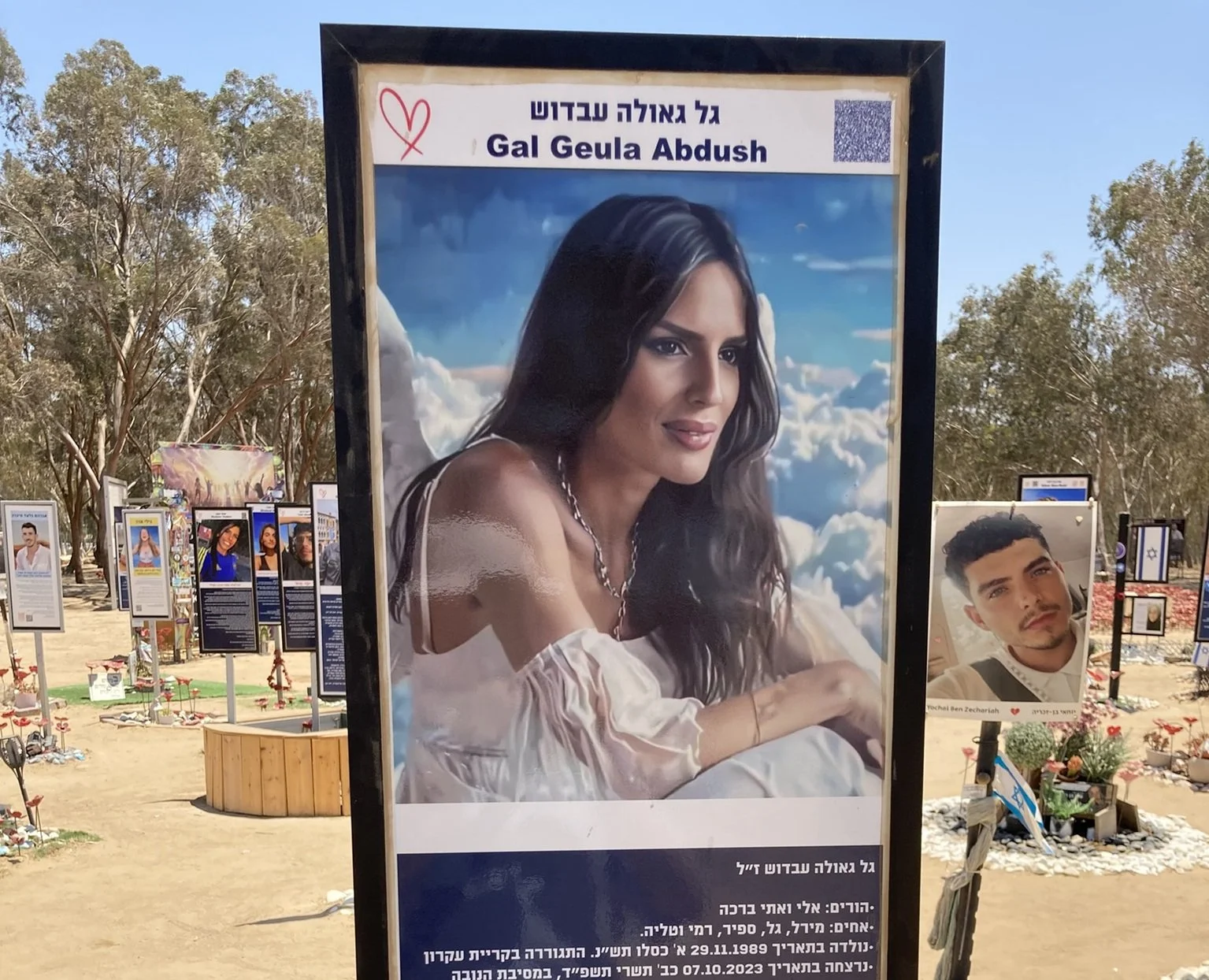











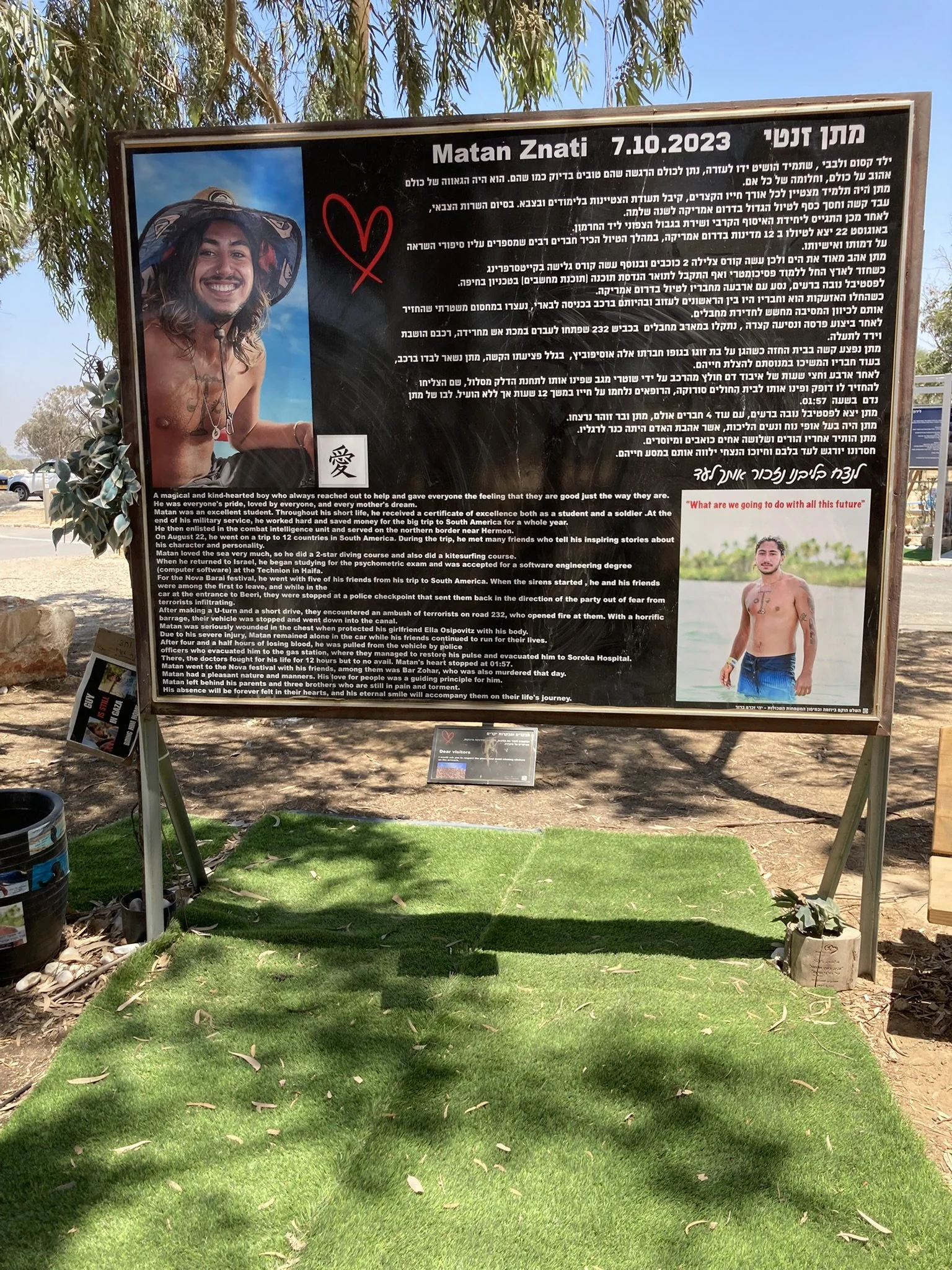












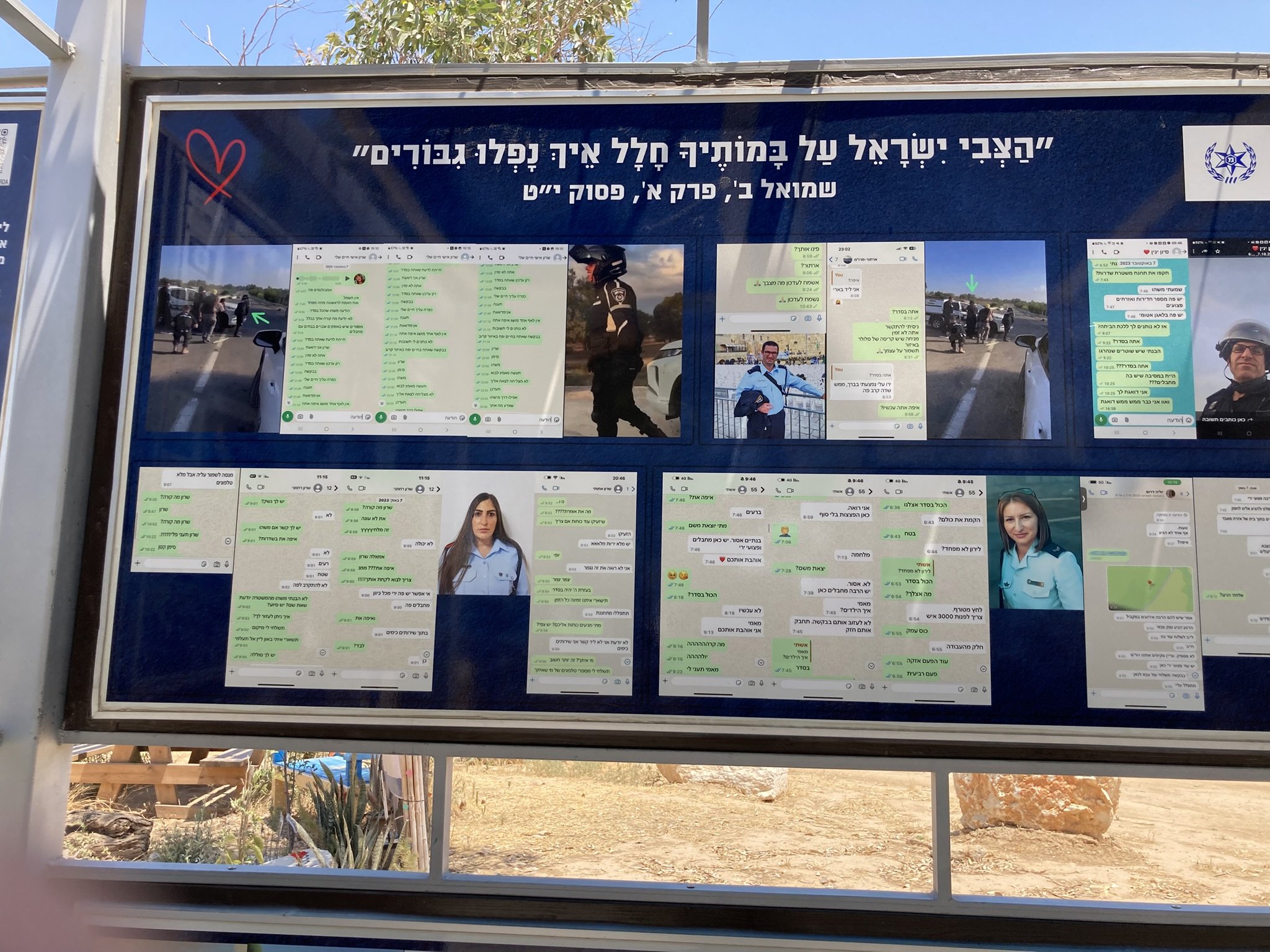







The story of the Tank at the Nova Festival
One of the most remarkable moments during the Nova Festival massacre was the unexpected arrival of a damaged Merkava tank. The tank had been hit earlier on the Gaza border and, by chance, made its way to the festival site.
The tank crew had been engaged in combat with terrorists who breached the border. During the battle, two crew members were killed, one of whom was abducted, and another died later from his injuries. One crew member, despite being wounded, assisted security before being fatally shot. The sole survivor managed to escape by driving over abandoned cars to shake off terrorists who had climbed onto the tank.
Roughly 30 festival ravers took shelter behind the abandoned tank. A widely shared account tells of two individuals who entered the tank and found a weapon, but it was clogged with sand and unusable. They asked if anyone had any kind of oil, and one young woman offered a small tube of Vaseline. Using it, they managed to clean and reactivate the weapon. With guidance from an IDF officer over the phone, they operated the tank’s machine gun to eliminate the terrorists, ultimately helping to save themselves and others.
Many of the ravers fled into nearby fields, orchards, or forests. Some reached nearby communities, while others were rescued by civilians driving into the chaos to help. Rescue forces arrived hours later and discovered over 260 victims. The final death toll reached 378, making it the deadliest terror attack in Israel’s history.
Today, in the very spot where the Nova Festival’s DJ booth once stood, scribes now sit and write Torah scrolls, a powerful symbol of remembrance, faith, and resilience.
Fifth Stop: Kibbutz Mefalsim
Kibbutz Mefalsim holds a powerful story from October 7, one that centers around a critical decision made by Moshe Kaplan, the kibbutz’s security coordinator and a member of the community.
Moshe is known by everyone for always carrying his weapon, no matter where he goes within the kibbutz. Prior to the attack, the military had issued an order requiring all kibbutz members to store their weapons in a centralized, secured storage room within the kibbutz. Moshe refused. He insisted that each member keep their weapon at home, ready for immediate access.
That decision proved to be vital.
When Hamas terrorists reached the kibbutz on October 7, they fired an RPG at the gate. Luckily, the gate was stuck and couldn’t be opened, preventing the attackers from entering the kibbutz with their vehicles. Forced to proceed on foot, the terrorists lost their tactical advantage.
Because weapons were already in their homes, members of the kibbutz were able to arm themselves quickly and to respond. They fought back fiercely and succeeded in eliminating all the Palestinian terrorists who attempted to infiltrate.
Moshe Kaplan’s refusal to follow the initial directive, and his belief in the need for immediate self-defense, may well have saved the lives of countless residents that day.
Sixth Stop: The Police Station in the City of Sderot





















Sderot, the Israeli city closest to the Gaza border, had long been a target of rocket attacks. On October 7, 2023, Hamas terrorists infiltrated the city using pickup trucks, aiming to seize the local police station. Along the way, they opened fire on civilians and police officers. Among their victims were 13 elderly Holocaust survivors, murdered near a public library while waiting in a minibus as part of a tour group.
The terrorists eventually took control of the police station, killing 35 people inside, both police officers and civilians. For 25 hours, the station remained under Hamas control until IDF and Yamam (Israeli counterterrorism forces) arrived. They first rescued several police officers who had taken shelter on the roof. After securing the officers, the IDF demolished the building using a tank and bulldozer to eliminate the remaining terrorists inside.
The tragedy in Sderot was not confined to the police station. Across the city, Hamas terrorists killed innocent civilians. In total, 52 Israelis were murdered in Sderot that day, including over 20 members of the security forces. Eight police officers were killed inside the station.
The site where the police station once stood is now a memorial to the fallen. Stone pillars mark the place, engraved with quotes from that harrowing day. One quote is from a 6-year-old girl named Romi Swissa, who asked the IDF soldiers:
“Are you of Israel?” "אתם של ישראל?"
Her story, and that of her baby sister, is one of both horror and resilience. As the attack unfolded, their parents attempted to flee the city by car. Hamas terrorists ambushed them and shot them on the spot. The parents were killed instantly, but miraculously, the two children survived by remaining silent in the back seat for hours. When IDF forces eventually arrived, they found the two girls still in the car. Aware that Hamas fighters had disguised themselves in Israeli army uniforms, the older sister, Romi, asked the soldiers with heartbreaking caution:
“Are you of Israel?”
This is only one of the many horrific stories that happened that day on October 7, 2023.
**************************
On October 7, 2023, approximately 1,200 civilians were brutally murdered by Hamas, and 251 hostages, including babies, children, women, men, and the elderly, were taken to Gaza.
As of today, 48 Israeli hostages remain in captivity.
Since the attacks, studies in Israel have documented a sharp and ongoing rise in mental health issues, including PTSD, depression, and anxiety. Around 100,000 Israelis remain displaced from their homes, unable to return to normal life.
To those who argue that Israel should have ended the war by now: the war could have ended long ago, if our hostages had been returned. Instead of pressuring Israel, the international community should have demanded that Hamas release the hostages and end the war.
Hedda Harari-Spencer, July 2025
To learn more about the events of October 7, 2023, and their aftermath, here are some recommended books with first-hand accounts, as well as the website Mapping the October 7 Massacre.






















